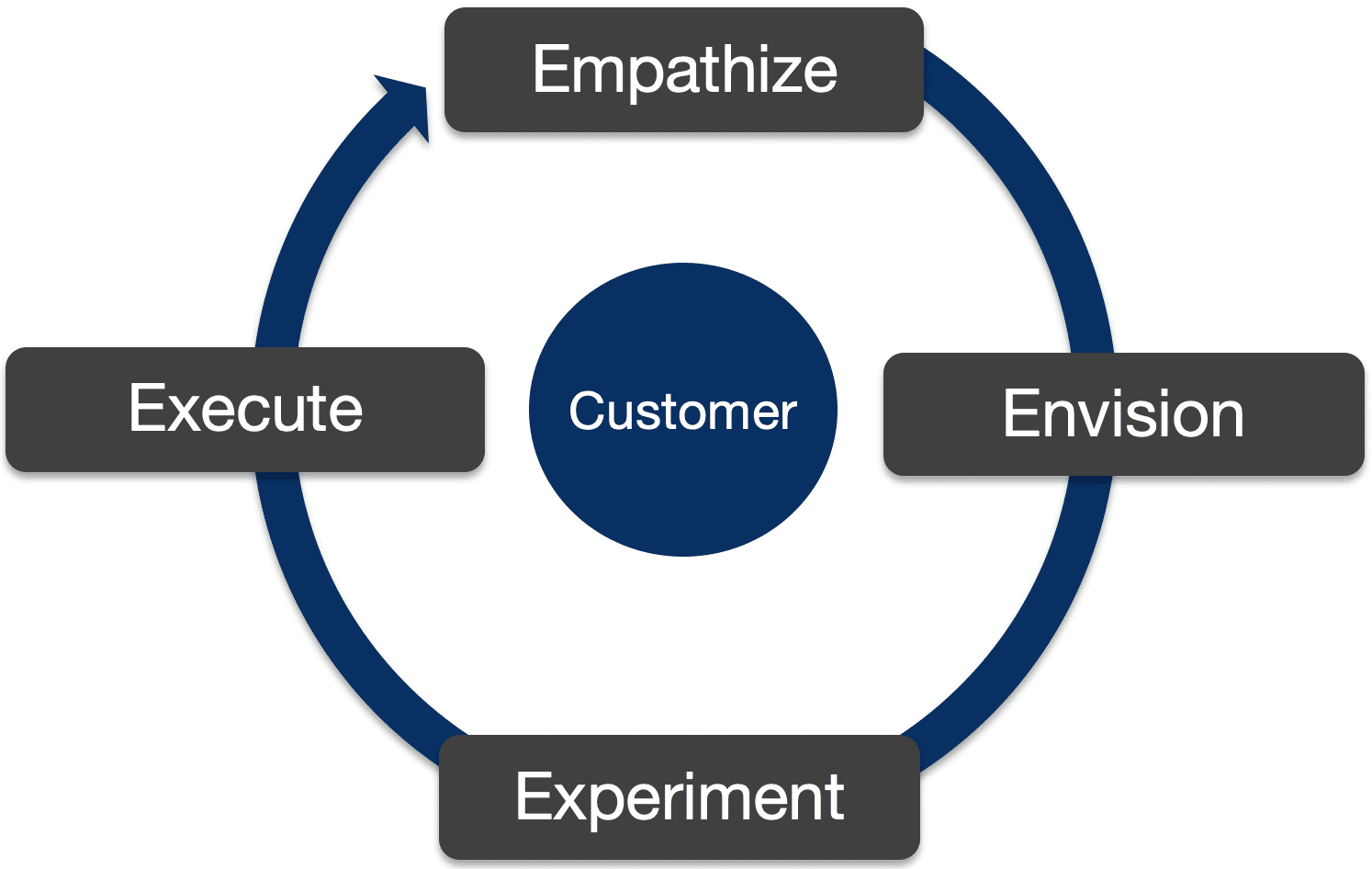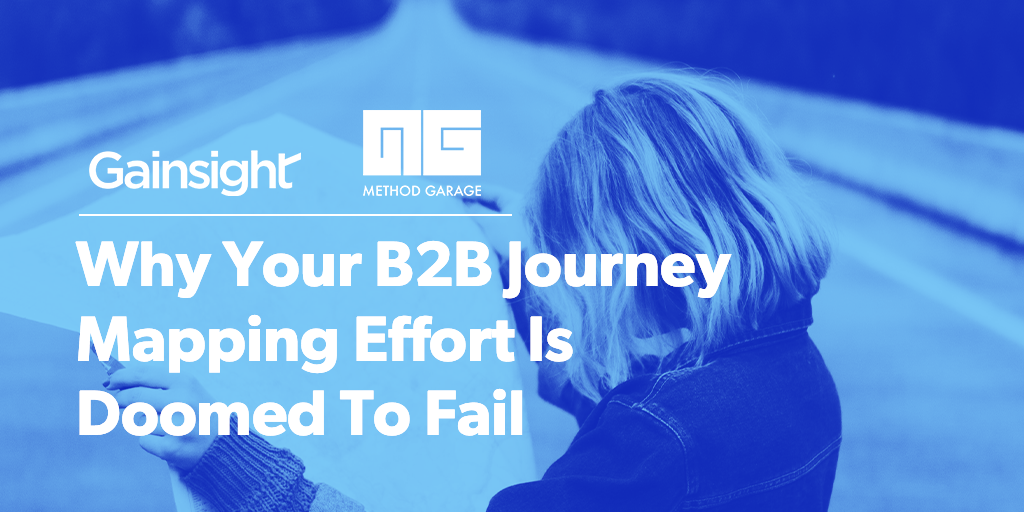We’ve all been there.
After months trying to convince colleagues, “Let’s do it right this time,” finally, everyone agrees to invest in a cross-functional B2B customer experience effort. We get everyone in a room together for a couple days. Post-it notes are everywhere, laying out our customer journey map. Several pots of coffee later, we think we have it. Yes! Kumbaya! But then… nothing happens. The journey map ends up sitting on a SharePoint somewhere, unshared and unused. Minimal impact. “What went wrong? I thought we nailed this…”
The reality is, B2B customer journey mapping is uniquely tough.
We have multiple stakeholders. “Whose journey are we mapping? Do we care most about the buyer or the person actually working with our product? We have 37 personas! What about partners?”
We have complex post-sale journeys. “Our prospects are already customers! Should we start with renewal? Isn’t the journey actually circular?”
We have tons of disconnected data. “How do we know what stage of the journey our customer is in? How healthy is this customer really?”
We have so many silos touching the customer. “Does anyone actually see the full customer experience? How many teams are engaged with an account at any given time? Should we have included Marketing in our workshop?”
But you don’t need us to tell you that. At Method Garage, our B2B customer experience firm, we’ve seen firsthand the confusion and anxiety that journey mapping projects can provoke in the people who lead them. Is there a template they should be using that they don’t know about? How many people should be on the core team? Would it be better to present their findings in a PowerPoint deck or a video? Are these even the right things to be worried about? (Tip: no).
There are certainly a lot of ways for B2B journey mapping to go wrong, but in this case, the devil isn’t in the details. What matters most is to get the big things right. And, when you do, the positive impact on your organization—and your customer—is massive. In that spirit, here are the five main B2B journey mapping concerns no one is really talking about—and how to work through them. Get these big questions right, and you’ll get the momentum you need from your journey mapping initiative.

1. Am I doing this for the right reasons?
If your reason is something along the lines of “it’s a best practice,” or “it’s an important part of the playbook,” or “everybody’s doing it,” you need to give it more thought. In B2B journey mapping as in everything else, the quality of your answers correlates directly to the quality of your questions.
What’s the business problem you want to solve, or the goal you want to achieve? Is it to gain insight into customer loyalty trends across segments? To get more bang-for-the-buck out of your customer success efforts? To provide a faster and more customer-friendly onboarding experience? To set customer experience priorities that truly reflect the needs and perspective of customers? The time you spend clarifying your objective is invaluable. Don’t even think about proceeding until you can complete the statement, “Through this effort, we will drive _______ for the business…”
2. Can we uncover the right insights?
In B2C, no one questions how to go about getting customer insights—you just go talk to them, observe them, do the research. Yet B2B pros go to extreme lengths to rationalize a different approach. “We’ve got plenty of data, surveys, and NPS comments, and a whole squad of subject matter experts on call—there’s no need to get live customers involved, is there?” Let’s just cut to the chase. If we want deep insight into our B2B customers’ journey, we need to ask them about it. Directly. Face-to-face.
Why would you water down your data set by relying solely on abstractions and second-hand anecdotes? You can’t develop real empathy without talking to real people, and real empathy is the foundation of every successful journey map. Conduct in-person interviews with your customers. Listen in on their support calls. Hear the confusion and frustration in their voices. Walk a mile in their shoes by navigating typical touchpoints yourself. You might be surprised by what you learn about the experience you’ve been providing, the assumptions you’ve been making about your customers, and the priorities you thought you’d been getting right. After all, when you’re doing this kind of research, an unexpected finding is pure gold.
3. Shouldn’t we inventory all of our customer interactions first?
Nope. It’s not about your touchpoints. Documenting the 250 types of interactions in your existing processes is a classic inside-out approach, taken from the company’s own perspective, that doesn’t tell you a thing about the customer’s point of view.
Instead of thinking in terms of spreadsheets with columns like “sales qualification call” and “project plan development,” take an outside-in approach by seeing everything through your customers’ eyes. As they interact with your product, what are the moments that matter most to them? What are they hoping to accomplish, what’s their state of mind, and how does their emotional state change as they navigate the experiences you provide? Are there moments missing—interactions the customer wants or expects to have at a given moment that aren’t being provided? On a fundamental level, what’s it really like to be your customer?
Here again we see the importance of talking to live customers. You can’t ask a bullet point how it’s feeling or what it wishes would happen instead.
4. Will people even care?
This one’s a classic sleep-destroyer. Stakeholders ignore my NPS reports and persona initiatives now. Why would this be any different? Am I just kidding myself? What if I do everything right, and this ends up buried in the obscure depths of SharePoint anyway?
You’re right to worry. Delivering B2B insights and hoping that people care is a low-percentage gamble. That’s why it’s crucial to improve your odds by building buy-in into your process from end to end. Get stakeholders in the loop from the very beginning and help them understand the point of the exercise—the specific, focused insights we talked about before—as well as the value it’ll deliver for their own work. Then, work openly and transparently so they’re invested along the way. Trickle interesting developments out to the broader organization—compelling customer quotes, interview clips, unexpected trends—the way a blockbuster movie assembles its audience through an extended sequence of trailers. Instead of having your big reveal come as a surprise, make it something people are looking forward to well in advance.
This obviously applies to executives and other stakeholders outside your customer experience/customer success organization, but we’ve also heard from customers who’ve struggled to get buy-in within their own teams. Don’t take this for granted, and never assume or hope that the right people will care. Make sure they do.
5. Will anything really change?
Short answer: no. Not if you stop at research. Getting everyone on the same page and seeing the big picture can be a great feeling, but if that’s all you achieve, your project has failed. Remember, your goal isn’t to create a journey map—it’s to achieve the business outcome you defined at the outset.

To drive real change, move beyond empathizing with the present to reimagining the future. Develop a vision for the better journey you want to provide, then create a future-state roadmap to get there. What are the landmarks and waystations on that map? What are the five or eight or ten concrete experiments that will move you forward? What design principles have you learned from the insights you’ve gathered, and what do they tell you about how to proceed now? You’ve got great momentum from your successful journey mapping project—now keep it going while interest and buy-in are high. You’ve done your homework. Now the real fun begins.
Still feeling anxious? It’s understandable—but hopefully you’re excited as well. Your B2B journey mapping effort will be one of the most important catalysts of customer experience change in your organization. Worry about the right things in the right way, and it’ll also be one of the best.
Read the rest of our CX series
Method Garage is the customer journey mapping firm for B2B technology companies.


